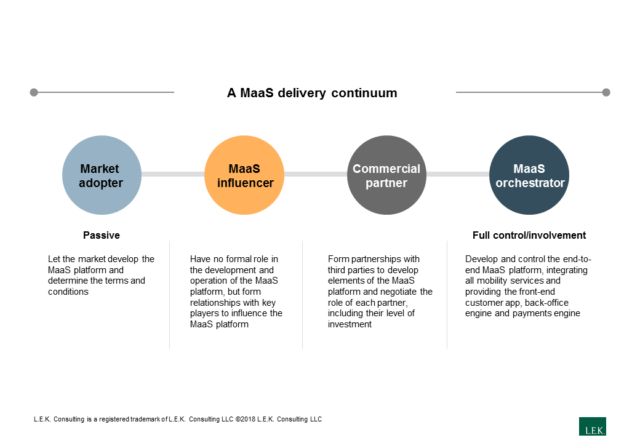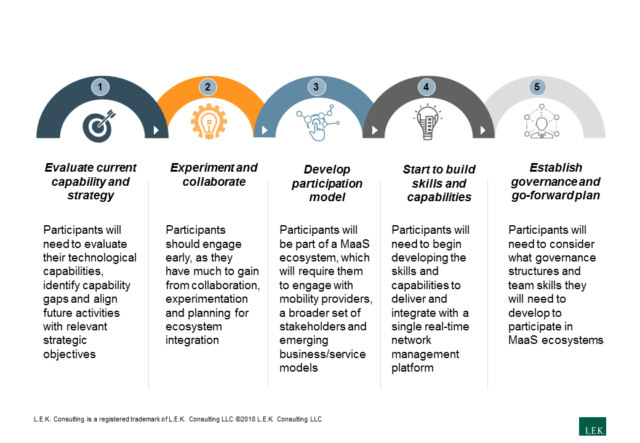
Making MaaS Happen
novembre 19, 2018 — The Big Picture
Traditional ways of thinking about mobility are increasingly being challenged. Mobility is now a complex web of decision-making for consumers. Mobility as a Service (MaaS) attempts to respond to these changes by developing transport solutions that are customer-centric.
What is MaaS?
MaaS is more than an “app.”
MaaS is a personal mobility option that puts the customer experience first, increasing convenience, effectiveness and satisfaction by enabling sharing and personalization through real-time connectivity.
However, MaaS can be as simple as a single mobile app that coordinates access to and use of public, private and active transport modes. Service information, journey planning and payment for such diverse services as bicycle hire, ride-sharing, car-sharing, road tolling and public transport can all be brought together on a single platform, with one account where customers can pay for the whole journey with “one click.”
How can parties participate in the MaaS ecosystem?
The appetite to deliver MaaS is growing quickly in both the public and private sectors. The potential models of participation range from “passive” to “active.” On the passive end of the spectrum are market adopters who will let the market develop the MaaS platform and determine the terms and conditions. Further along are MaaS influencers, who have no formal role in the development and operation of the MaaS platform but form relationships with key players to influence the MaaS platform. Next, commercial partners will form partnerships with third parties to develop elements of the MaaS platform and negotiate the role of each partner, including their level of investment. At the active end of the spectrum are MaaS orchestrators who seek to develop and control the end-to-end MaaS platform. They will integrate all mobility services and provide the front-end customer app, back-office engine and payments engine.

Ultimately, the role selected by participants will depend on a range of factors, including strength of brand, approach to customer acquisition and retention, funding sources, appetite for quality control, and existing organizational capabilities. For example, a participant taking on a MaaS orchestrator role will need technical and digital development capabilities as well as strength in partnering and contract negotiation to secure third-party mobility suppliers.
What does success look like?
Many of the challenges associated with large-scale MaaS deployment are well-understood. It is therefore important to initiate pilots and trials to start the journey and realize some “quick wins.”
For example, responding to the growing momentum for governments around the world to deliver MaaS models, the New Zealand Transport Agency (NZTA) piloted a free real-time mobility app for travelers to Queenstown and Auckland. L.E.K. Consulting Australia was engaged by NZTA to develop the strategic business case for the MaaS proof-of-concept pilots.
The objective was to successfully demonstrate the deliverability and benefits of MaaS for consumers. The pilots help visitors plan for and navigate all their transport needs by bringing them together with transport providers on one platform with real-time transport options.
L.E.K. worked with NZTA to establish the strategic context for the MaaS proposition in New Zealand, including developing the strategic business case for the national MaaS platform, the economic business case for the pilots, and the commercial business case setting out how the pilots would work in practice and the steps to implementation.
The Queenstown Choice pilot app was successfully launched in August 2017, with the Auckland RideMate app subsequently released in December that year. Both pilots were received positively for delivering a unique consumer-centric travel experience. New features are in development, and the government is considering further scaling of the New Zealand MaaS marketplace.
What are the current challenges to success?
Currently, various parts of the MaaS ecosystem have achieved different maturity levels. For example, advanced journey planners are available, but end-to-end payment and pricing platforms are generally not yet well-developed. Together with regulatory and commercial considerations (for example), there are clearly a number of challenges to be addressed in order to see the successful implementation of holistic MaaS platforms.
Now is the time to work through the opportunities presented by MaaS at a strategic level and develop a clear way forward, while working on implementation challenges in parallel. These decisions will be informed by the intended objective and dimensions of the MaaS use case, including the geographic coverage, modal scope and platform functionality. However, many participants struggle to appropriately define these options in order to tailor their MaaS offering to capture their desired target market.
There are five key actions transport organizations can consider to start participating in the MaaS ecosystem:
1. Evaluate technological capabilities — identify capability gaps and align future activities with relevant strategic objectives
2. Experiment and collaborate — there is much to be gained from early collaboration, experimentation and planning for ecosystem integration
3. Develop a participation model — being part of a MaaS ecosystem will require engagement with mobility providers, a broader set of stakeholders and emerging business/service models
4. Start to build skills and capabilities to deliver and integrate with a single real-time network management platform
5. Establish a governance structure, go-forward plan and required team skills

MaaS represents a significant opportunity for all participants in the mobility ecosystem. Social and demographic trends and the popularity of various integrated mobility apps suggest that consumers want MaaS. It is important for transport agencies to reflect on their ambitions for MaaS, consider their role in its delivery, evaluate alternative solutions and delivery models, and consider the organizational capabilities they will need to deliver a MaaS platform.